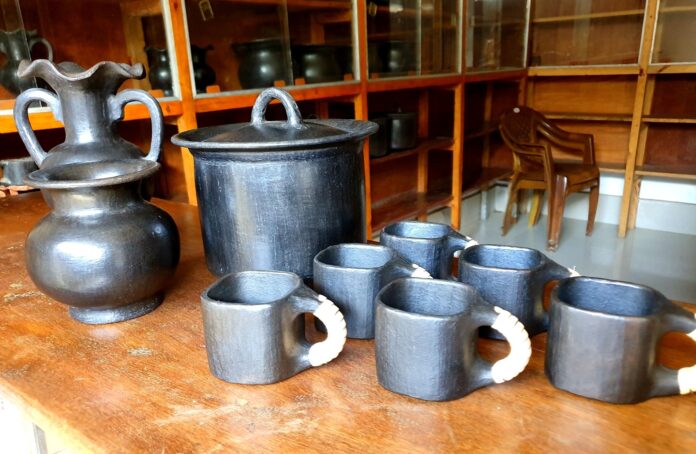Deep within the heart of Tripura, a time-honored craft flourishes, captivating the senses with its distinctive beauty and cultural significance. The traditional black pottery of Tripura, with its rich heritage and intricate craftsmanship, showcases the skill and creativity of the artisans who have mastered this age-old art form. In this article, we delve into the fascinating world of Tripura’s black pottery, exploring its origins, techniques, and the efforts to preserve this valuable cultural heritage.
Origins and Cultural Significance:
The roots of black pottery in Tripura can be traced back to ancient times when it served as an essential part of the region’s daily life. This traditional craft holds immense cultural significance for the indigenous communities of Tripura, reflecting their customs, beliefs, and way of life. The pottery was not merely functional but also played a role in various rituals and ceremonies, symbolizing prosperity, fertility, and protection from evil spirits.
Unique Characteristics and Techniques:
Tripura’s black pottery stands out for its distinct appearance and distinctive techniques. The pottery is characterized by its deep black color, achieved through a unique firing process using traditional kilns and organic materials. The artisans skillfully mold the clay into various forms, ranging from utilitarian items like pots, bowls, and utensils to decorative pieces such as figurines, vases, and lamps.
The pottery-making process involves several intricate steps, beginning with the selection and preparation of the clay, which is then shaped on a potter’s wheel or by hand. The artisans employ their expert craftsmanship to create intricate designs, patterns, and motifs, often inspired by nature, folklore, and tribal traditions. After shaping, the pottery is sun-dried and carefully polished before being fired in the kiln, where the magic happens, transforming the clay into its signature black hue.
Preservation Efforts and Contemporary Adaptations:
In recent years, there has been a growing recognition of the need to preserve and promote Tripura’s traditional black pottery. Artisan communities, government initiatives, and cultural organizations have come together to support the artisans and ensure the continuity of this unique craft. Efforts have been made to document the traditional techniques, train the younger generation in the art form, and create market opportunities to sustain the livelihoods of the artisans.
Furthermore, contemporary adaptations and innovations have breathed new life into Tripura’s black pottery. Artisans are experimenting with modern designs, incorporating new materials and techniques while maintaining the essence of the traditional craft. These contemporary adaptations have not only expanded the appeal of black pottery but have also opened avenues for economic empowerment and cultural exchange.
Preserving Tripura’s Cultural Heritage:
The preservation of Tripura’s traditional black pottery goes beyond safeguarding a craft; it is about preserving the identity and heritage of the indigenous communities. By supporting and promoting this unique art form, we contribute to the cultural diversity and sustainable development of Tripura. It is essential to appreciate and celebrate the artistry, skill, and resilience of the artisans who have dedicated their lives to the craft, ensuring that their legacy lives on for generations to come.
Tripura’s traditional black pottery is a testament to the artistic excellence and cultural richness of the region. It is a captivating craft that reflects the deep-rooted traditions and beliefs of the indigenous communities. Through preservation efforts, awareness, and support, we can honor and celebrate Tripura’s black pottery, ensuring its continued legacy and the empowerment of the talented artisans who have kept this remarkable craft alive for centuries. Let us embrace the beauty and significance of Tripura’s black pottery and cherish it as a treasure of our cultural heritage.



